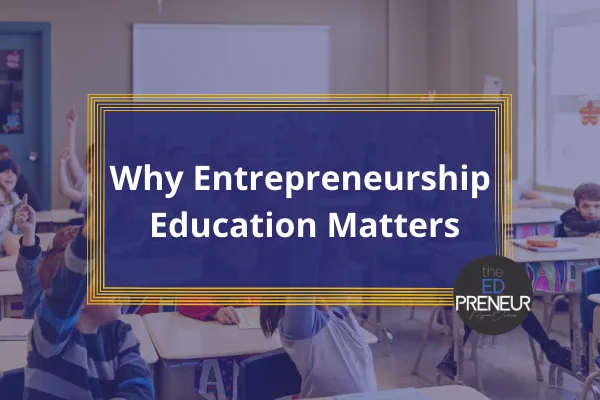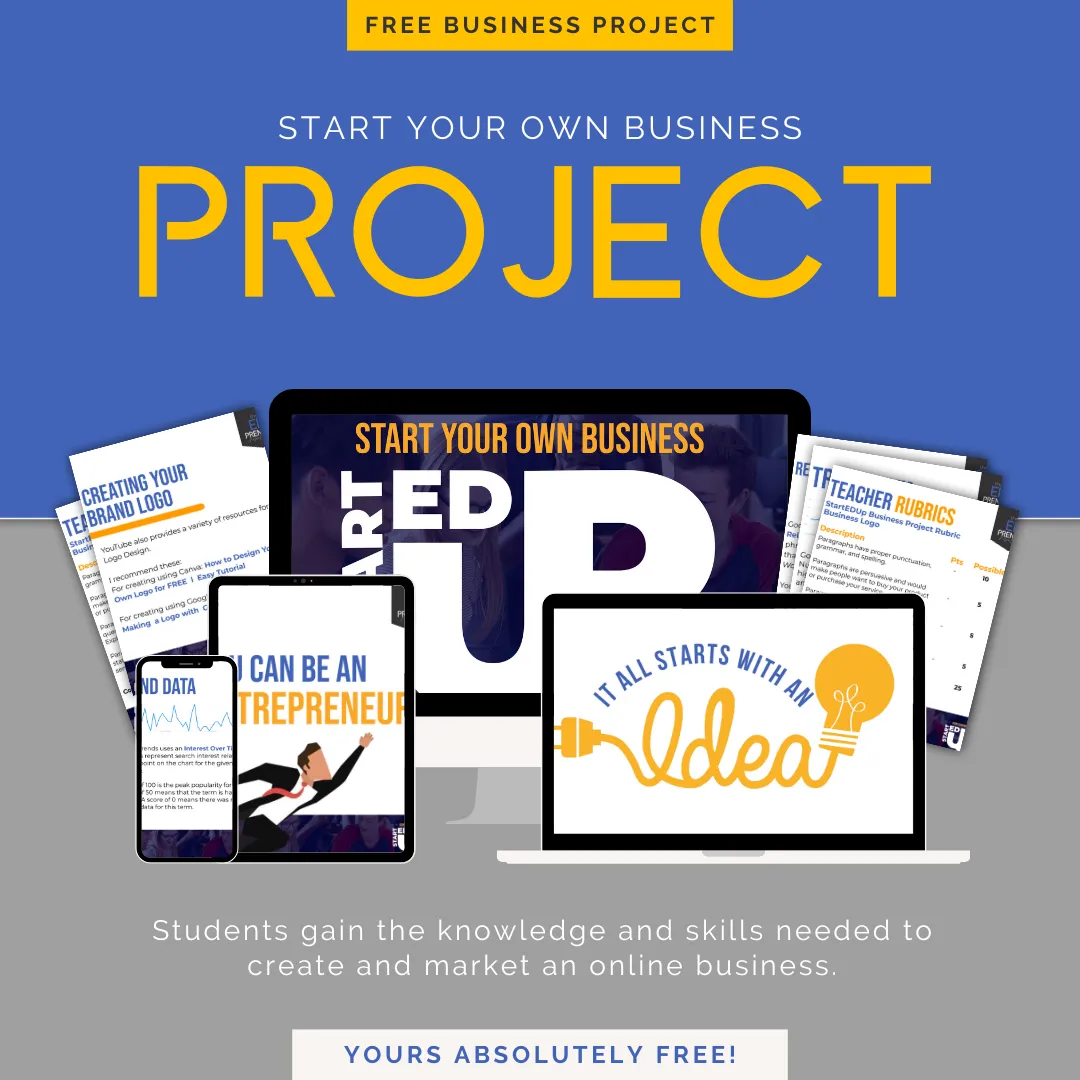
Entrepreneurship is a powerful tool teachers can use to cultivate a passion for learning and ignite creativity in their classroom.

From Classroom to CEO: How Entrepreneurship Education Can Help Your Students Thrive in the Real World
From Classroom to CEO: How Entrepreneurship Education Can Prepare Your Students for Success in the Real World
Introduction:
In today's rapidly transforming world, students need more than just academic knowledge to achieve success in both their career and personal lives. They also need to develop skills like creativity, critical thinking and problem-solving - essential attributes in today's and tomorrow's economy. That is where entrepreneurship education comes into play - teaching students how to identify problems, devise solutions and design innovative products or services with purpose; equipping them for entering the workforce or even starting their own businesses.
In this blog post, we'll dive deeper into the topic of entrepreneurship education, primarily in elementary and middle schools. We'll cover its benefits, strategies for incorporating it into curriculums, as well as case studies of successful entrepreneurship programs. By the end of it all you'll have a better idea how entrepreneurship education can prepare your students to thrive in today's marketplace and how you can implement it into your classroom setting.
Entrepreneurship Education Provides Many Advantages
Entrepreneurship education has numerous advantages for students of all ages, especially those in elementary and middle schools. Here are some key advantages associated with infusing entrepreneurship into the classroom:
Entrepreneurship Inspires Creativity and Innovation:
Entrepreneurship education encourages students to think outside the box and come up with creative solutions for problems. By teaching them how to identify problems and create unique products or services, entrepreneurship education can foster creativity and innovation.
Entrepreneurship Develops Critical Thinking and Problem Solving Skills:
Entrepreneurship education requires students to analyze complex situations, make decisions, and solve problems. By practicing these abilities in a safe classroom setting with a supportive teacher, students can develop essential critical thinking and problem-solving abilities that will serve them throughout their lives.
Entrepreneurial Thinking Builds Confidence and Resilience:
Starting a business can be intimidating, requiring hard work and perseverance. By teaching entrepreneurship in the classroom, students learn to embrace challenges and overcome obstacles with greater assurance, helping build their confidence and resilience - essential qualities for success in any field and in life!
Entrepreneurial Thinking Prepares Students for the Future Workforce:
Entrepreneurship education can prepare students for today's workforce, which increasingly values creativity and innovation. By teaching students how to be creative problem solvers, entrepreneurs, and leaders, entrepreneurship education will give them a competitive edge in the job market.
Entrepreneurship Fosters Social Responsibility:
Entrepreneurship education can instill a sense of social responsibility in students. By motivating them to create products or services that address real-world problems, entrepreneurship education helps them recognize the significance of making an impact on society. They learn that it's not just about making a profit, but making a positive impact on the people and world around them.
Overall, entrepreneurship education offers many advantages to students in elementary and middle schools. By encouraging creativity, critical thinking, and problem-solving abilities, it can prepare them for success in the real world - whether they become entrepreneurs or pursue other careers.

Strategies for Teaching Entrepreneurship in the Classroom
Now that we've discussed the advantages of entrepreneurship education, let's dive in and discuss some practical strategies for teaching it in the classroom. Here are some tips for incorporating entrepreneurship education into your curriculum:
Start With the Fundamentals:
Before students venture into entrepreneurship, it's essential for them to develop an understanding of basic business concepts such as profit, loss, revenue, and expenses. Using real-life examples to help your students make connections between these ideas is a great way to cultivate their learning. The hit show, "Shark Tank", is a great medium for helping your students make these connections. I created a complete guide that I use in my own classroom to help my students recognize and understand these key business concepts while we watch an episode of Shark Tank.
Utilize Project-Based Learning:
Project-based learning is one of my preferred ways to introduce entrepreneurship in the classroom. Have students collaborate in teams on creating a product or service and creating a business plan for it. This can help develop teamwork, problem-solving abilities, and communication abilities. I created a classroom version of Shark Tank that I love doing with my middle school students. Using this project-based learning activity, I'm able to infuse technology tools, creative thinking and problem solving skills that are essential for teaching entrepreneurship.

Invite Guest Speakers:
Have local entrepreneurs speak to your class about their experiences starting and running a business. This can give students valuable insights into the real-world difficulties that entrepreneurs face, while motivating them to pursue their own entrepreneurial ventures.
Integrate Technology:
Technology is a crucial asset for entrepreneurs, so ensure your students have access to computers, tablets and other devices. Show them how to utilize technology for research and developing their business ideas.
Connect With the Community:
Engage local businesses and organizations to give your students hands-on experiences in entrepreneurship. You could arrange for students to visit a nearby business or organization, or invite entrepreneurs to speak directly in your classroom.
Integrate Entrepreneurship Throughout Subjects:
Entrepreneurship education can be integrated with many subjects, such as math, science, social studies and language arts. For instance, you could teach math by having students calculate profit margins or teach science by having them create eco-friendly products.
By implementing these strategies, you can help your students develop the necessary abilities and knowledge to be successful both in the modern workplace and their personal lives.
Case Studies of Successful Student Entrepreneurship Programs
There are numerous examples of successful entrepreneurship programs in elementary and middle schools throughout the United States. Here are a few case studies that showcase its potential:
Lemonade Day:
Lemonade Day is a national program that instructs young children how to open and operate a lemonade stand. It provides them with an entrepreneurship curriculum and toolkit for starting their own businesses, while teaching them financial literacy, marketing strategies, customer service skills as well as the value of giving back to their communities. Since 2007, Lemonade Day has reached over 1 million children across America.
BizWorld:
BizWorld is an educational program that imparts entrepreneurial and financial literacy to children in grades 3-8. Through hands-on projects and activities, pupils develop essential skills such as critical thinking, problem-solving, and communication. Children work in teams to come up with business ideas, design business plans, and pitch their plans to potential investors. Since 1997, BizWorld has reached over 750,000 children from 100 countries.
Future Founders:
Future Founders is a non-profit organization that provides entrepreneurial education programs to students from K-12. They offer resources and programs such as an annual business pitch competition for high school students and summer entrepreneurship camp for middle schoolers. Since 2005, Future Founders has assisted over 30,000 students develop their entrepreneurial skillset.
These are just a few examples of successful entrepreneurship programs in elementary and middle schools. By learning from these examples, you can gain valuable insight into creating effective education programs for your own students on entrepreneurship.
Conclusion
To effectively teach entrepreneurship in the classroom, it's essential to begin with fundamentals. If you're just starting out, I would gradually implement project-based learning activities, integrate technology, and make some attempts engage with your community. Utilizing these strategies will allow you to put together an effective entrepreneurship education program that gives your students hands-on experience and practical real world knowledge.
Implementing entrepreneurship education into your curriculum may seem intimidating, but with the right resources and support it can be a rewarding and fulfilling experience for both you and your students. By cultivating their entrepreneurial spirit, you are helping them become successful, confident leaders of tomorrow - equipped with all of the skills needed to thrive in today's globalized world.

About Ryan...
Ryan and his wife, Ashley, are both full time educators. Ryan is an entrepreneur at heart and currently manages multiple online businesses. His experiences in online business grew into a passion for helping other teachers introduce their students to the power entrepreneurial thinking in their own classrooms.
Ryan created The EDpreneur curriculum of resources to help teachers ignite a spark in their classrooms and activate a new passion for learning through problem solving and an entrepreneurial mindset.

I'D LIKE TO SEND YOU A FREE LESSON!
Just tell me where to send it...
Are you a TpT Teacher Seller?

